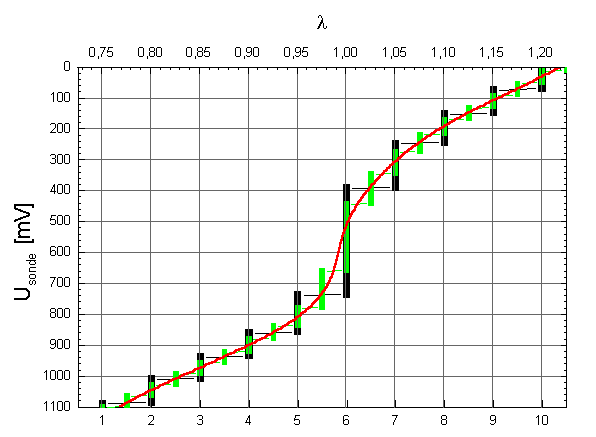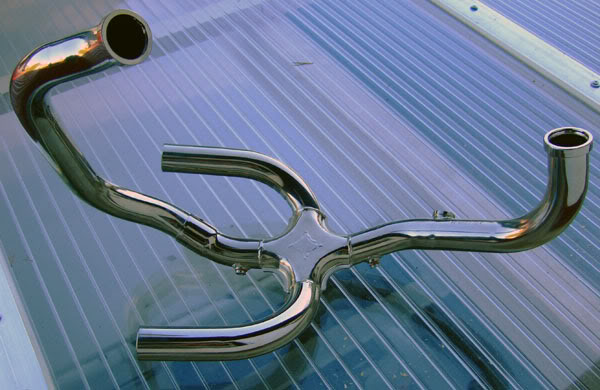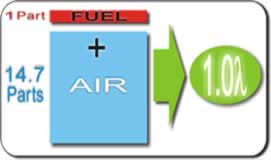a few years ago there was an article on two sites of silent-hektik.com about lambda meters. Unluckily they are long down.
I had saved the pages but they are in german and unluckily missing all the pictures. Anyway this may be interesting for some of you:
Here a fast translation (modified auto translation):
title:
a lambda-meter almost for free
The lambda sond (probe)
For the tuning useful Lambda probes cost around 300, - to 400, - DM ($ 140-190) ea. in a shop. If one does not necessarily need a broadband measuring instrument, but only wants to check (measure) one or two work areas of the engine, also an inexpensive probe from a passenger car can do a good job. Used probes can originate from accidented cars from a recycler. Usually only 30, - to 50, - DM ( $14-24) are due. In any case it should be a four-wire probe. The manufacturer is unimportant. Two connectors are the heating, the two others are the signal. The connections should be checked according to vehicle wiring diagram.
The indicator
For the display of the probe signal an inexpensive circuit analyzer (multi-meter) from an electronic shop will do. It should have a DC voltage measuring range of 0-2V. If the display is analogue or digital is not important. With analogues (with needle) however the intermediate values can be determined more easily. One already gets such a circuit analyzer for 20,- DM ($ 8,50).
The assembly
For the assembly of the probe to the exhaust manifolds two threaded collars are needed. Each is welded or hardsoldered approx. 50cm after the exhaust valve (logically a hole has to be drilled in the headers). A version out of stainless steel does not rust later. The sleeves an be bougt from many dealers in stock; or manufactures (Ducati sells `em incl. a screw to tap the hole), according to the accompanying sketch. (price is around DM 50,- ($24) for 2)
see here:
http://www.silent-hektik.com/page75.html (not existing anymore)
The equalizing (how to use the multi-meter as lambda-meter)
The equalizing of the "Lambdameter" is necessary, so that the result of measurement has also a predicate. For it find a AU measuring place (at many gas stations and workshops). (ask a garage who does emmision tests - AU btw. is the german emmission test)
With the engine at operating temperature at idle adjust the mixture adjusting screw on first 0,8La and write down the voltage from the digital circuit analyzer (multi-meter) you`ve connected to the lambda sond or make a mark if you use an instrument with a scale line. Then follows 0,85La, then 0,9La, then 0,95La. More values are not needed. You have now created your own reliable lambda-meter.
The result will be something like this:

The tuning
The global-tuning takes place basically in driving, because on a test stand only the full load (full power) area is tuned.
An engine has it`s max. performance with approx. 0,88La to 0,90La (rich mixture). The engine has smallest consumption with still acceptable running culture (smoothness) with approx. 0,90La to 0,95La. When accelerating it should be 0,8La, in order to receive a spontaneous acceleration.
With Lambda 1.0 to 1.1 the engine has the smallest pollutant proportions with smallest gasoline consumption, but also a smaller performance with increased gasoline consumption, with increased engine temperature and particularly with miserable runnig culture. At values under 0,7La (very rich) or over 1,2La (very lean) usually the ignition boundary is achieved; the engine stutters.
Sorry for the bad automatic translation, but I don`t have any more time !
I think this is a great way to fiddle around a bit on the carburation by yourself with only a little bit of investment. Btw. Micron sells a small meter + lambda-sond for $ 190 or so.
---------------------------------------------------------------------------
http://www.silent-hektik.com/page74.html (not existing anymore)
for the graphics on the page:
P = power
b = fuel consumption
Emissionen = emissions
Lambdaspannung = lambda voltage
The theory
For burnung a part of gasoline 14.7 parts of air are needed, to receive a theoretically full-coming burn. The relation of the value of supplied air to the theoretically needed air is the lambda value:
In the theory optimally:
14.7 / 14.7 = 1.00 Lambda
Too little air:
13.0 / 14.7 = 0.88 La - > rich
Too much air:
17.0 / 14.7 = 1.16 La - > lean
From the right diagram is evident, that max. performance and minimum consumption is not at the same time possible, even if some tuners say this.
All the same whether carburetors or injection, when tuning a compromise must be found. This is usually situated with Lambda 0.88 to 0,92. The Lamda value is measured with the help of a Lambda probe. This zirconium dioxide probe (on the right) supplies a voltage, which can be analysed by electronics.
A typical probe voltage is to be seen in the lower diagram.
The tuning
Per HP and hour an Otto engine needs 250 gram gasoline (330mL) to unfold the max. performance. An Otto engine has the max. performance with approx. 0,85La to 0,90La (rich mixture).
G.





